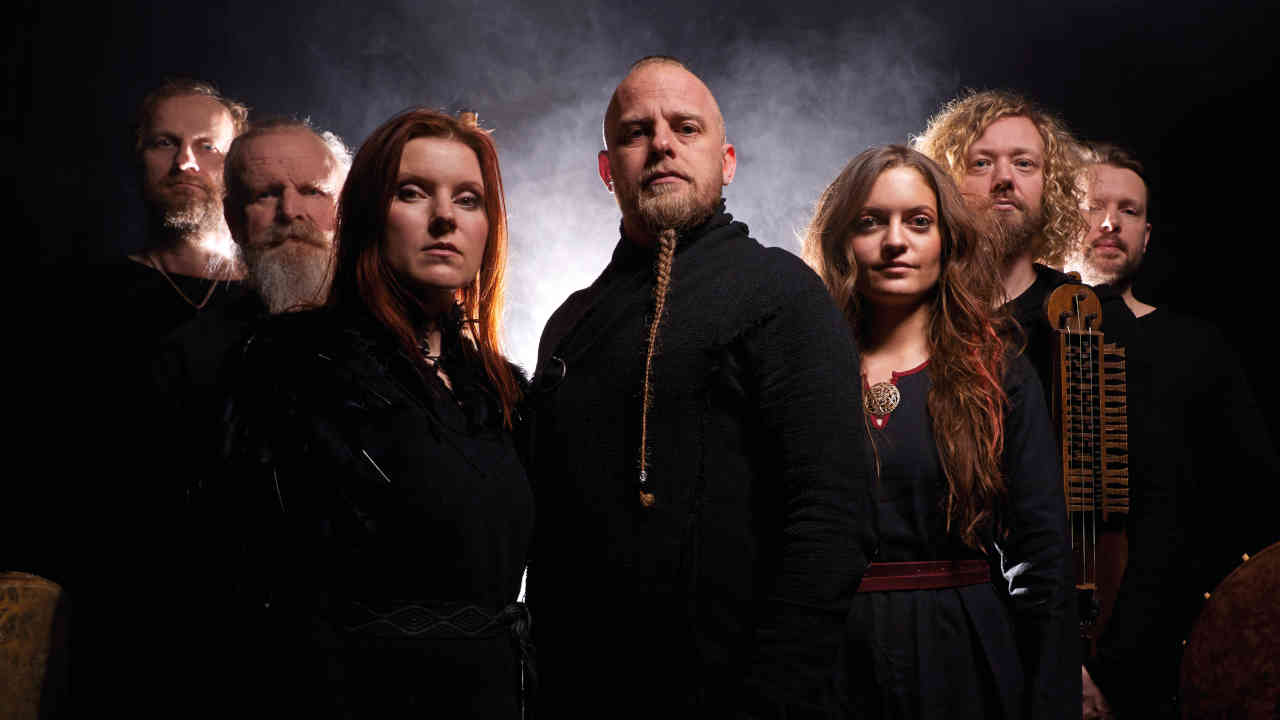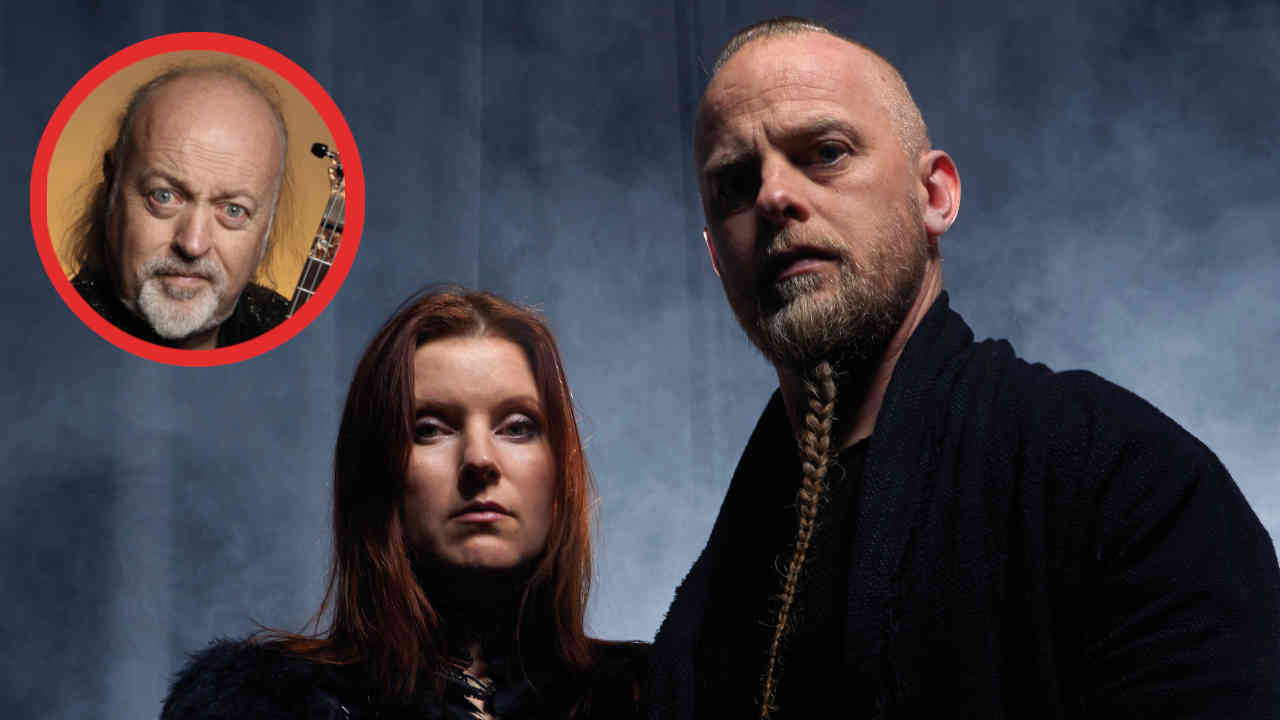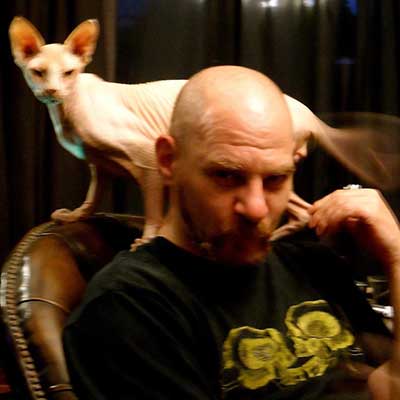The mutual respect is apparent the moment Einar Selvik and Bill Bailey appear in their separate Zoom windows.
Einar is the founder of Wardruna, the Norwegian pagan folk collective formed in 2003, whose deep dive into ancient Norse culture has resulted in one of the most transformative, enrapturing experiences of the wider metal world. Amplified by their collaboration with the Vikings TV series and now the epicentre of a wider spiritual movement, they’re a phenomenon in their own right, and a deeply resonant anchor in a world undergoing great upheaval.
Renowned stand-up comic, multi-instrumentalist, actor, Enter Sandman-tangoing Strictly Come Dancing champion and all-round British institution, Bill Bailey is another artist who, for all his commanding presence, seems to belong as much to other, more noble ages as our own.
It comes as no surprise that he’s a huge fan of Wardruna, and as they make their introductions, Einar professes his love for Black Books and Bill’s all-round works, both revealing a congenial awe, humility and genuine, receptive curiosity that makes their conversation a thoroughly illuminating meeting of minds.

Hammer: Bill, when did you first hear Wardruna?
Bill Bailey: “I’m very interested in traditional and folk music, and music from northern Europe really, because that’s where I feel the strongest connection, in a way. Actually, I did a DNA test with the National Geographic, and it said I was 2.8% Neanderthal, which I was very pleased about. I told my family and they just shrugged and said, ‘Only 2.8? We thought it would be more’. [It was actually 1.5% – Geeky Science Ed.] And also, it turns out I’m 60% Norse.
“But I was invited to perform in New Zealand, and I was in quarantine for two weeks in a hotel. I started listening to the new album, Kvitravn, and I was completely entranced by it. I was allowed out for 40 minutes a day for exercise, so every day when I went out, I had Wardruna in my headphones, and that got me through it. What I love about the music is that it’s transformative. It takes you to another place and time. It was like some kind of Norse ceremonial, tribal, processional music, but it sounds ancient and modern at the same time.
Bill: “Einar, you use lots of sound effects: there are ravens and wind, and the sound of footsteps and stones, so it conjures up the landscape, and it forges that bond between music and the land, which I feel very strongly about. So I’m a big fan of your work, which I think is fantastic.”
Einar Selvik: “Wow. Like you say, it merges the contemporary with the ancient, both when it comes to the themes and the music. They didn’t have scores back then, but when you dig into all the sources that are there, it’s like a giant jigsaw puzzle, and there is actually quite a lot that can be said about how music sounded like back then.
“The mantra that I’ve been working with since the beginning is that a tree without roots will fall – or don’t climb into trees that don’t have roots. So when I do these songs or dive into these themes or work with certain instruments, it’s important that I start off on solid ground before going into these creative processes.
I apply my own interpretations, but always starting out with something we know, or we think we know. I do believe that’s partly why it resonates with so many people today; there are many things from the past that don’t really carry the same relevance anymore, but there are so many things that are universal that are worth remembering. In some cases, we almost need them more today. It might come in this old Norse wrapping, but the heart of it is nature. It’s our relationship to nature, to each other and to something that’s bigger than yourself.”
Bill: “Do you think there’s been a greater hunger for that in the last couple of years, because of what the world has been through? We’ve been through this strange, unsettling situation that’s made us appreciate the natural world more.”
Einar: “Absolutely. I think a lot of people found the medicinal effect of being outdoors again and that will be a lasting epiphany. There are many people who are drawn to a more natural state of things, and art and music can be an important bridge, especially if you are in a city.”
Bill: “Is Bergen where you formed Wardruna?”
Einar: “Yeah, I come from an island called Osterøy, just north of Bergen, and the musical scene in Bergen is quite vibrant. I come from metal music; I played in Gorgoroth and several other bands in the early 2000s, but I had the need to do something I was more connected to on a personal level, and had a passion for.
So I went back into the shadows and just started over again. There was a lot of music that used elements from the old Norse history and of course metal music used a lot of the imagery, but I really wanted to use relevant sounds, instruments, words, to record in relevant places. It was everything – states of mind, weather, anything I could do to get as close as possible to what I’d envisioned.”
Bill: “You use traditional instruments, and I read that you’ve actually constructed or reconstructed some of them.”
Einar: “Yeah, in the beginning, I basically had to, because at that point there weren’t a lot of people who knew anything about them, let alone knew how to build them. So some of them I had to build myself and some I had people build for me. And then of course there are a handful of ancient instruments that we actually have a living tradition of using still, so there are still a few builders left making them, like the long horns and the goat horns, instruments like that, which you can date back to the Bronze Age.”
Bill: “One of the instruments I was going to ask you about was the tagelharpa. It’s an old lyre, but it’s bowed.”
Einar: “It’s basically a bowed lyre, or a horse hair fiddle. It’s one of the oldest bowed instruments we know about in Scandinavia. Exactly how old it is, we don’t know. There is a stone carving in one of the cathedrals in Trondheim, and there you have this little grim gargoyle playing one of these, and I think it’s from the 12th century, but there are traces that suggest it’s a few 100 years older.
‘Tagel’ means ‘horse hair’, so you just take horse hair and twirl it a little bit and tie it up. You don’t have a fingerboard so you just touch the strings, like a Mongolian instrument.”
Hammer: “The erhu is like that, isn’t it?”
Bill: “Yeah, I use one in my show, but I use the digital version – there’s an erhu in GarageBand on the iPhone, and I hook it up to the speakers and I play along with some samples and the theremin, and you can see people going, ‘Well, this instrument sounds like it’s from another age’, but I’m like, ‘No, it’s right there on your phone! You can try it yourself.’ But I love that.
Bill: What comes across, Einar, is that you are very much a student of music and history. One of the things I’m interested in about you is your use of runes. You studied them quite extensively. How does that play into the music?”
Einar: “My fascination for them started in my early teens, and I was lucky in that I was encouraged to read up on the sources rather than the New Age books on them. So studying the history of runology was an important starting point.
For me, the runes are writing, but they also have a more esoteric side to them. Each one has a symbolic value. It has a phonetic sound. The root of the word, ‘ru’, basically means ‘creating sound’, and around the Viking Age, the word could mean a number of different things. It can refer to the written sign, it can mean ‘a secret’, it can mean ‘wisdom’, and it can even mean ‘a magical song’.
“Looking at them as a whole system, I found them to be very good images to display various aspects of the old Norse way of viewing the world, and very good tools to tell that story. And like I said before, I was trying to interpret them as much as possible on their own premise. Like if I was working with the rune representing the birch tree, I went into the forest and played on birch trees, and used the sound of the bark and the leaves.
If you dig a bit deeper, into other poetry regarding the runes, you find all sorts of other nerdy details, like branch runes. If you use a branch rune, it’s said that you only use the branch that is leaning towards the east, so then I only play the branch is leaning towards the east.”

Bill: “You’re getting into it very deeply there, Einar! That is a level of commitment that is absolutely great. I want to ask you about the work you did for the TV series Vikings. You wrote a lot of music for it. What was that process, and was there any feedback into your own projects?”
Einar: “Yeah, I had limited experience in terms of working with music for the screen. It started with them licensing quite a few of the Wardruna songs, and then they asked me if I wanted to work with the main composer of the show.
So I did that, it was a steep learning curve, and, of course, working with instruments like these, most people who work with score music, it’s a lot of drag and drop, they sit with their keyboards. So working with these brutal deadlines, with the tagelharpa and quite a few of these instruments, they don’t always play along if they don’t want to. That’s the beauty, but also the challenge of using nature instruments, they don’t always perform when they must. So you need to be a little bit flexible.
So that part was very challenging, the time aspect of it, but also I think I learned a lot. So even though I don’t think I took any direct musical inspiration from that work into my own work, on the other hand, everything that you do, everything you learn, every growth you have, influences your work in the times to come as well. So in some ways I definitely took experiences from that process into the work with Wardruna as well.”
Bill: “I always think that with any kind of collaboration, it makes you examine your own working process again. I worked with an orchestra a few years ago, and I tend go with whatever inspiration I have at that moment. Working with an orchestra, of course, they are quite disciplined. They need to have certain breaks, and that I found quite difficult at first to adapt to. So as you say, your processes become more disciplined. I found myself working in a better way.”
Einar: “Yes, and I would say, that process of working with Vikings definitely made me more efficient. I have no musical education, which is a blessing in many cases, because I don’t have any rules in my head. But at the same time, when working with an orchestra, or a music composer, it can, of course, be a little bit impractical.”
Bill: “How did working with Lindy-Fay Hella come about?”
Einar: “Even before I started Wardruna, I knew that I was going to work with her at some point. The first time I heard her, in a café in Bergen, the voice just spoke very strongly to me. She has a Sami origin [nomadic people living chiefly in North Scandinavia], which is very clear in her voice. So when I started the first recordings around 2002, I already had her in mind. Thankfully, she agreed to be part of Wardruna, and it was also a place for her to connect with that side of her heritage as well.”
Bill: “It’s a wonderful combination, I have to say. A lot of your songs have this powerful beat, and then her voice floats over the top, and it creates this vastness.”
Einar: “Yeah, she has a very unique voice, and a very unique understanding of music as well, which is really interesting to work with. It’s like working with these old instruments in a way, because you never know exactly what you are going to get. It’s hard to plan it, she’s just a force of nature.”
Bill: “There’s a universality to your music I think, that really connects with people on a different level, almost a spiritual level, around the world.”
Einar: “You have quite a bit of knowledge about music from all over the world, and the interesting thing is that if you go far back enough in time, you see how connected traditional music is, whether it’s the tonalities, the instrument types or rhythmical patterns. The resemblances are striking. Maybe it’s coded in our DNA, so it simply must trigger us. These are things that are so primal in us human beings, so universal and timeless, and that is why it speaks to us.”
Hammer: “There’s a musical culture that’s grown up around Wardruna, with other bands starting to pick up these instruments. When did you start noticing that happening?”
Einar: “I think when we started doing it, we were tapping into a need, or a desire, or a void that was there, and I think that void is what I was feeling when I created it. I wanted to hear music like this. There were bands around that used elements of it, but I wanted to step into it with both feet. Judging from the response ever since, there was a need for it, or a potential for it. And of course, when you do that, when you create a new genre in a way, people will become inspired, and I think that’s a good thing. I’m honoured to have inspired other people to do similar things, or have their own take on it. In the last five or so years it’s just exploded.
“That’s the cool thing about folk music. I really see the value and importance of traditional music, which is about keeping the tradition, and then the folk part of it is more alive, and that changes all the time. It comes in new waves, and there is definitely one of these new waves going on right now. Based on what I hear, you can easily tell the difference between those who still play mostly on the modern interpretation or assumptions of how music sounded back then and those who do their homework.”
Bill: “You’re a man after my own heart, Einar, that’s exactly what I do. Thank you for all the wonderful music that you’ve made. If you ever need a drummer or tagelharpa player, just give me a call.”

